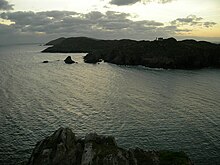
The sack of Baltimore took place on 20 June 1631, when the village of Baltimore in West Cork, Ireland, was attacked by pirates from the Barbary Coast of North Africa – the raiders included Dutchmen, Algerians, and Ottoman Turks. The attack was the largest by Barbary slave traders on Ireland.[1][2]
The attack was led by a Dutch captain from Haarlem, Murad Reis the Younger, who had been enslaved by the Barbary pirates and set free following his conversion to Islam. Murad's force of the Salé Rovers was led to the village by an Irish Catholic fisherman of Old English descent named John Hackett – the captain of a fishing boat that had been captured shortly before the raid – purportedly in exchange for his release, although dark conspiracy theories regarding Hackett, Sir Walter Coppinger, and Murad persist (see Sack of Baltimore#Conspiracy theory). Hackett was subsequently hanged from the cliff-top outside the village for conspiracy.[3][4]
- ^ Ó Domhnaill, Rónán Gearóid (2015). Fadó Fadó: More Tales of Lesser-Known Irish History. Troubador Publishing Ltd. p. 33. ISBN 978-1-78462-230-5.
- ^ Wilson, Peter Lamborn (2003). Pirate Utopias: Moorish Corsairs & European Renegadoes. Autonomedia. pp. 119, 121. ISBN 978-1-57027-158-8.
- ^ Ó Domhnaill, Rónán Gearóid (2015). Fadó Fadó: More Tales of Lesser-Known Irish History. Troubador Publishing Ltd. p. 34. ISBN 978-1784622305. Retrieved 15 June 2015.
The truth soon emerged and he was hanged from the cliff top outside the village for his conspiracy
- ^ Corporation, Kinsale, Ireland (1879). The Council Book of the Corporation of Kinsale, from 1652 to 1800. J. Billing and sons. pp. xxxiii–xxxv.
{{cite book}}: CS1 maint: multiple names: authors list (link)